汽车仪表板材料和保险杠材料光老化性能研究
刘 强,王文涛,李 莉,李慧连,王 俊,揭敢新,张晓东
(1.浙江吉利汽车研究院有限公司,杭州 311228;2.中国电器科学研究院工业产品环境适应性国家重点实验室,广州 510300)
汽车仪表板材料和保险杠材料光老化性能研究
刘 强1,王文涛1,李 莉1,李慧连1,王 俊2,揭敢新2,张晓东2
(1.浙江吉利汽车研究院有限公司,杭州 311228;2.中国电器科学研究院工业产品环境适应性国家重点实验室,广州 510300)
采用汽车行业内常用的光老化试验方法,主要针对汽车仪表板材料和汽车保险杠材料,展开了光老化研究,一方面比较了常用的光老化试验方法对汽车零部件材料老化严酷程度的影响,另一方面对比了不同零部件材料的耐光老化性能。研究结果显示,对于仪表板材料的光老化行为,3种常用试验方法的老化严酷程度基本表现为方法二>方法三>方法一,仪表板材料A和材料B的耐老化性能基本一致;对于保险杠材料的光老化行为,3种常用试验方法的老化严酷程度基本表现为方法四>方法六>方法五,保险杠材料D的耐光老化性能优于材料C。
汽车;仪表板材料;保险杠材料;光老化性能;色差;光泽
1 前言
随着我国汽车产业的快速发展,对汽车品质要求逐渐提高,汽车老化性能也备受关注,汽车工业的快速发展逐渐带动了汽车老化性能的研究[1,2]。通常所讲的汽车老化,主要是指汽车非金属零部件的光老化,非金属材料耐光老化性能不足直接影响了零部件的耐光老化程度;汽车内外饰非金属零部件直接或间接受到光照的影响,极易导致老化现象的发生,因此内外饰材料的耐光老化性能尤为重要[3]。
汽车仪表板作为主要的内饰零部件,间接受阳光光照影响比较严重,表面易产生发白、发粘等老化现象,影响外观和使用;汽车保险杠作为主要的外饰零部件,直接受阳光光照影响严重,表面易产生变色、粉化、开裂等老化现象,影响外观和安全[4]。
本文主要从仪表板材料和保险杠材料着手,采用汽车行业常用的光老化试验方法[5~10]对仪表板材料和保险杠材料进行光老化研究,一方面比较各光老化试验方法对材料老化严酷程度的影响,另一方面对比不同材料的耐光老化性能。
2 试验方法及设备
2.1 样品准备
仪表板材料选用材料A(PP+EPDM-TD20-1)和材料B(PP+EPDM-TD10-1),保险杠材料选用材料C(PP+EPDM-TD10-2)和材料D(PP+EPDM-TD20-2),分别按照试验方法的要求制备成标准样板。
2.2 试验方法
仪表板材料光老化试验方法见表1。

表1 仪表板材料光老化试验方法Table 1 The light-aging test method of the instrument panel material
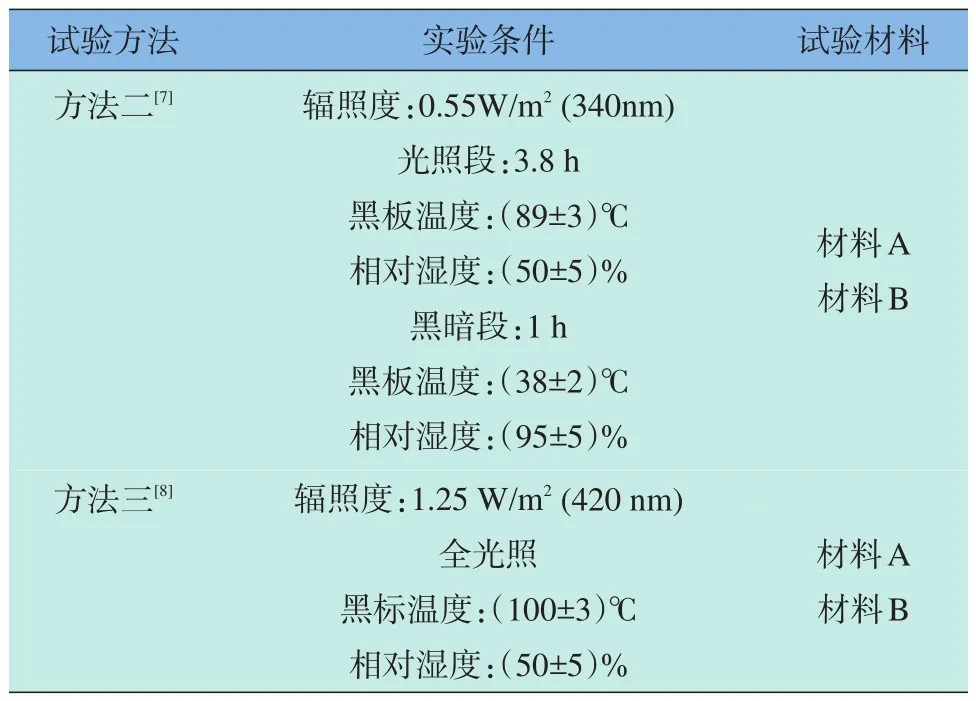
续表
保险杠材料光老化试验方法见表2。

表2 保险杠材料光老化试验方法Table 2 The light-aging test method of the bumper material
2.3 试验设备
氙灯老化试验箱:美国Atlas Ci4000。
3 试验结果与分析
3.1 仪表板材料光老化研究
汽车仪表板作为主要的汽车内饰零部件,属于内饰零部件中间接受光照影响较为严重的零部件,针对其材料的光老化进行研究,对其他内饰零部件材料的光老化研究具有指导性。选择仪表板材料A和材料B,采用方法一、方法二、方法三分别对两种材料进行光老化试验,对其老化结果进行色差和光泽分析。
由图1可以看出,在3种试验方法中,仪表板材料A的色差变化趋势基本重合,均随着辐照量的增加呈现上升趋势,均是在试验初始阶段迅速上升到色差为2左右,然后缓慢变化,累计辐照量达到700 MJ/m2后迅速上升。从图2可以看出,在3种试验方法中,仪表板材料B的色差变化趋势与材料A有所差别,在试验初始阶段,色差变化波动较小,在方法一和方法二试验中,累计辐射量达到450 MJ/m2后,色差变化迅速上升,而在方法三试验中,累计辐射量达到700 MJ/m2后色差变化迅速上升。
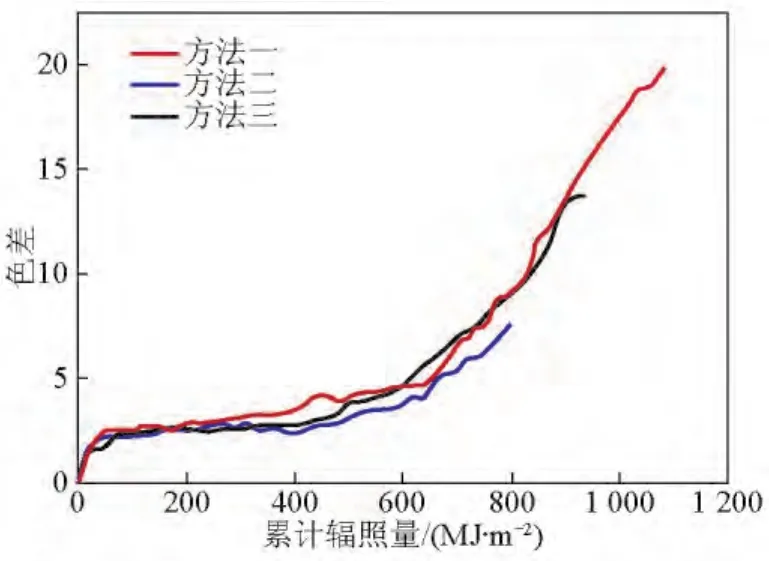
图1 仪表板材料A光老化试验中色差变化状况Fig.1 The variety conditions of the color difference in the light-aging test of the instrument panel material A
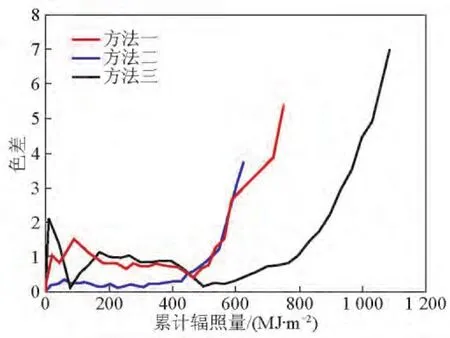
图2 仪表板材料B光老化试验中色差变化状况Fig.2 The variety conditions of the color difference in the light-aging test of the instrument panel material B
由图3、图4可以看出,在3种试验方法中,仪表板材料A和材料B的光泽保持率均随着辐照量增加而呈现下降趋势。如果以材料A和材料B的光泽保持率作为判断老化程度的依据,则三种试验方法的老化严酷程度基本表现为方法二>方法三>方法一。

图3 仪表板材料A光老化试验中光泽变化状况Fig.3 The variety conditions of the gloss in the light-aging test of the instrument panel material A

图4 仪表板材料B光老化试验中光泽变化状况Fig.4 The variety conditions of the gloss in the light-aging test of the instrument panel material B
由仪表板材料A和材料B光老化试验中光泽和色差的变化状况可知,材料A和材料B的耐光老化性能基本是同等的。
3.2 保险杠材料光老化研究
汽车保险杠作为主要的汽车外饰零部件,属于外饰零部件中直接接受光照影响较为严重的零部件,针对其材料的光老化进行研究,对其他外饰零部件材料的光老化研究具有指导性。选择保险杠材料C和材料D,采用方法四、方法五、方法六分别对两种材料进行光老化试验,对其老化结果进行色差和光泽分析。
由图5可以看出,保险杠材料C在3种试验方法中,色差呈现出不同的变化,累计辐射量达到700 MJ/m2之前,材料C在3种试验方法中,色差变化基本一致;累计辐射量达到700 MJ/m2之后,方法四试验中,色差迅速上升;累计辐射量达到1 200 MJ/m2之后,方法六试验中,色差才呈现上升趋势,而在方法五试验中,累计辐射量达到1 800 MJ/m2之后,色差才呈现上升趋势。如果以材料C的色差作为判断老化程度的依据,则3种试验方法的老化严酷程度基本表现为方法四>方法六>方法五。
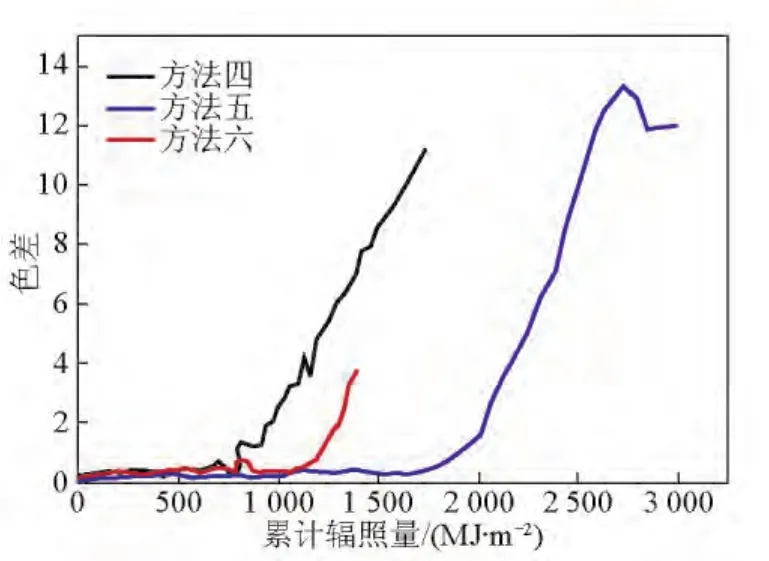
图5 保险杠材料C光老化试验中色差变化状况Fig.5 The variety conditions of the color difference in the light-aging test of the bumper material C
由图6可以看出,保险杠材料D在3种试验方法中,在累计辐射量达到2 000 MJ/m2之前,色差基本没有呈现较大的变化。

图6 保险杠材料D光老化试验中色差变化状况Fig.6 The variety conditions of the color difference in the light-aging test of the bumper material D
由图7、图8可以看出,累计辐射量达到300 MJ/m2之后,在3种试验方法中,保险杠材料C光泽保持率均呈现迅速下降的趋势,保险杠材料D光泽保持率呈现缓慢下降的趋势。如果以材料C和材料D的光泽保持率作为判断材料老化程度的依据,则3种试验方法的老化严酷程度基本表现为方法四>方法六>方法五。
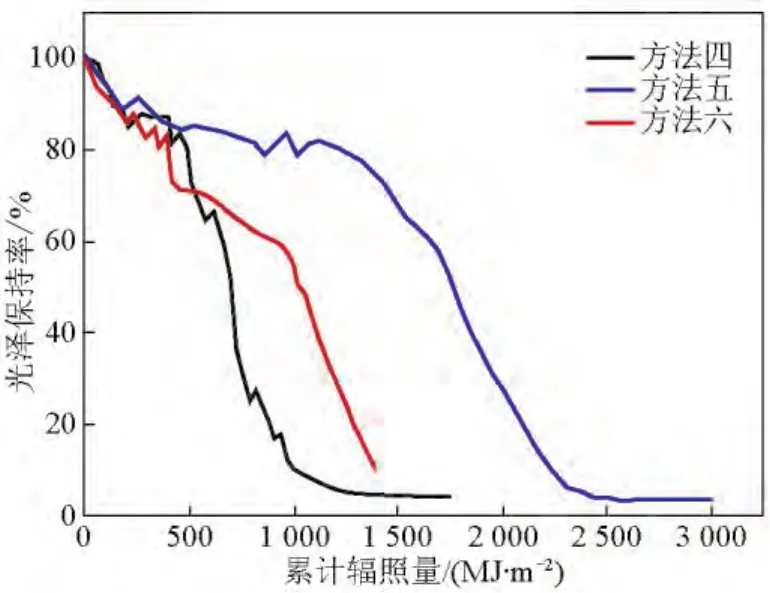
图7 保险杠材料C光老化试验中光泽变化状况Fig.7 The variety conditions of the gloss in the light-aging test of the bumper material C

图8 保险杠材料D光老化试验中光泽变化状况Fig.8 The variety conditions of the gloss in the light-aging test of the bumper material D
综合保险杠材料C和材料D在光老化试验中色差和光泽的变化,也可以得知材料D的耐光老化性能优于材料C。
4 结语
本文针对汽车仪表板材料和保险杠材料的耐光老化性能进行了研究,研究结果对汽车企业选择合适的耐光老化试验方法和耐光老化的汽车内外饰零部件材料都具有重要的指导性意义。
1)对于仪表板材料的光老化行为,3种常用试验方法的老化严酷程度基本表现为方法二>方法三>方法一。
2)对于保险杠材料的光老化行为,3种常用试验方法的老化严酷程度基本表现为方法四>方法六>方法五。
3)通过光老化试验,仪表板材料A和B的耐光老化性能基本一致,保险杠材料D的耐光老化性能优于材料C。
[1]刘树文,蒋祖华,祁 黎.汽车非金属材料的实验室加速老化和户外自然老化[J].广东塑料,2005,5:44-45.
[2]刘冠文,苏仕琼.塑料人工气候老化试验[J].合成材料老化与应用,2007,36(2):35-39.
[3]王 俊,揭敢新,彭 坚.汽车保险杠用聚丙烯材料的老化研究[J].装备环境工程,2010,7(3):10-13.
[4]陆启凯,揭敢新,王 俊.汽车气候老化试验技术[M].广州:华南理工大学出版社,2010.
[5]赖建萍,王一临.汽车内饰材料的人工老化试验[J].装备环境工程,2007,4(1):35-40.
[6]Volkswagen.PV 1303—2001 Non-metallic materials exposure test of passenger compartment components[S].2001.
[7]Society of Automotive Engineers.SAE J2412—2004 Accelerated exposure of automotive interior trim using a controlled irradiance water cooled xenon-arc apparatus[S].2004.
[8]国家质量技术监督局.GB/T 16422.2—1999塑料实验室光源暴露试验方法第2部分:氙弧灯[S].北京:中国标准出版社,1999.
[9]Volkswagen.PV 3929—2004 Non-metallic materials weather aging in dry,hot climate[S].2004.
[10]Society of Automotive Engineers.SAE J2527—2004 Accelerated exposure of automotive exterior materials using a controlled irradiance xenon-arc apparatus[S].2004.
A study on light-aging resistance of instrument panel materials and bumper materials on the automobile
Liu Qiang1,Wang Wentao1,Li Li1,Li Huilian1,Wang Jun2,Jie Ganxin2,Zhang Xiaodong2
(1.Zhejiang Geely Automobile Research Institute Co.Ltd.,Hangzhou 311228,China;2.State Key Laboratory of Environmental Adaptability for Industrial Products,China National Electric Apparatus Research Institute,Guangzhou 510300,China)
The light-aging test method commonly used in the automobile industry is utilized to carry out light-aging research on automotive instrument panel(IP)materials and bumper materials.On one hand,the impacts of common light-aging test methods on aging degree of automotive component materials are compared;on the other hand,the light-aging resistances of different component materials are compared.The results show that,for light-aging behavior of IP materials,the aging degree of the third test method is not severer than that of the second method,but it is severer than that of the first method.The light-aging resistance of IP material A is almost the same as that of IP material B.With reference to light-aging behavior of bumper materials,the aging degree of three common test methods indicates that the aging degree of the sixth test method is not severer than that of the fourth method,but it is severer than that of the fifth method.The light-aging resistance of bumper material D is superior to that of bumper material C.
automobile;IP materials;bumper materials;light-aging resistance;color difference;gloss
TB32
A
1009-1742(2014)01-0099-04
2013-10-08
刘 强,1970年出生,男,山东鱼台县人,高级工程师,博士研究生,主要从事轻量化、汽车环保、材料耐候性能等研究;E-mail:liuqiang@rd.geely.com

